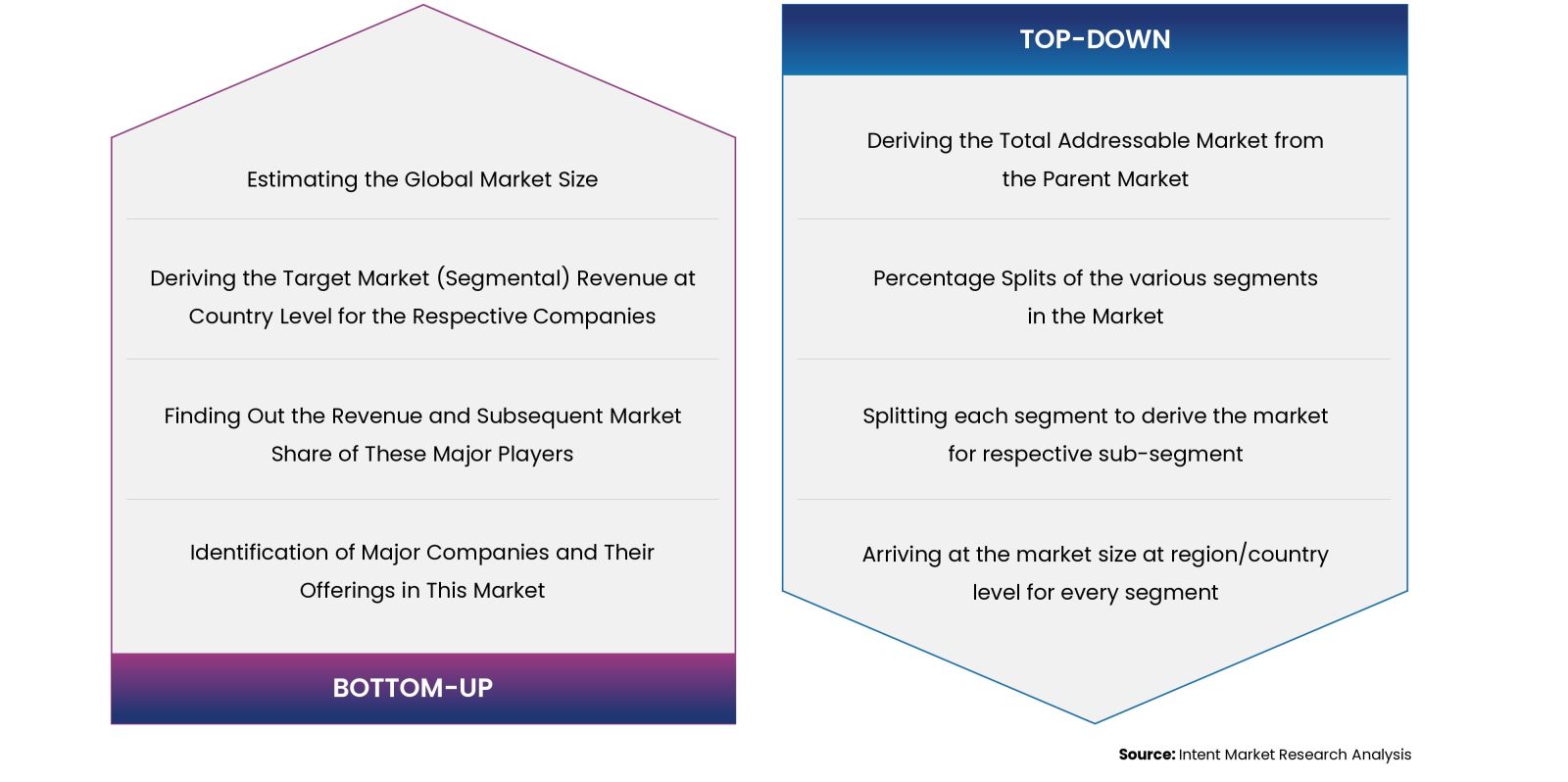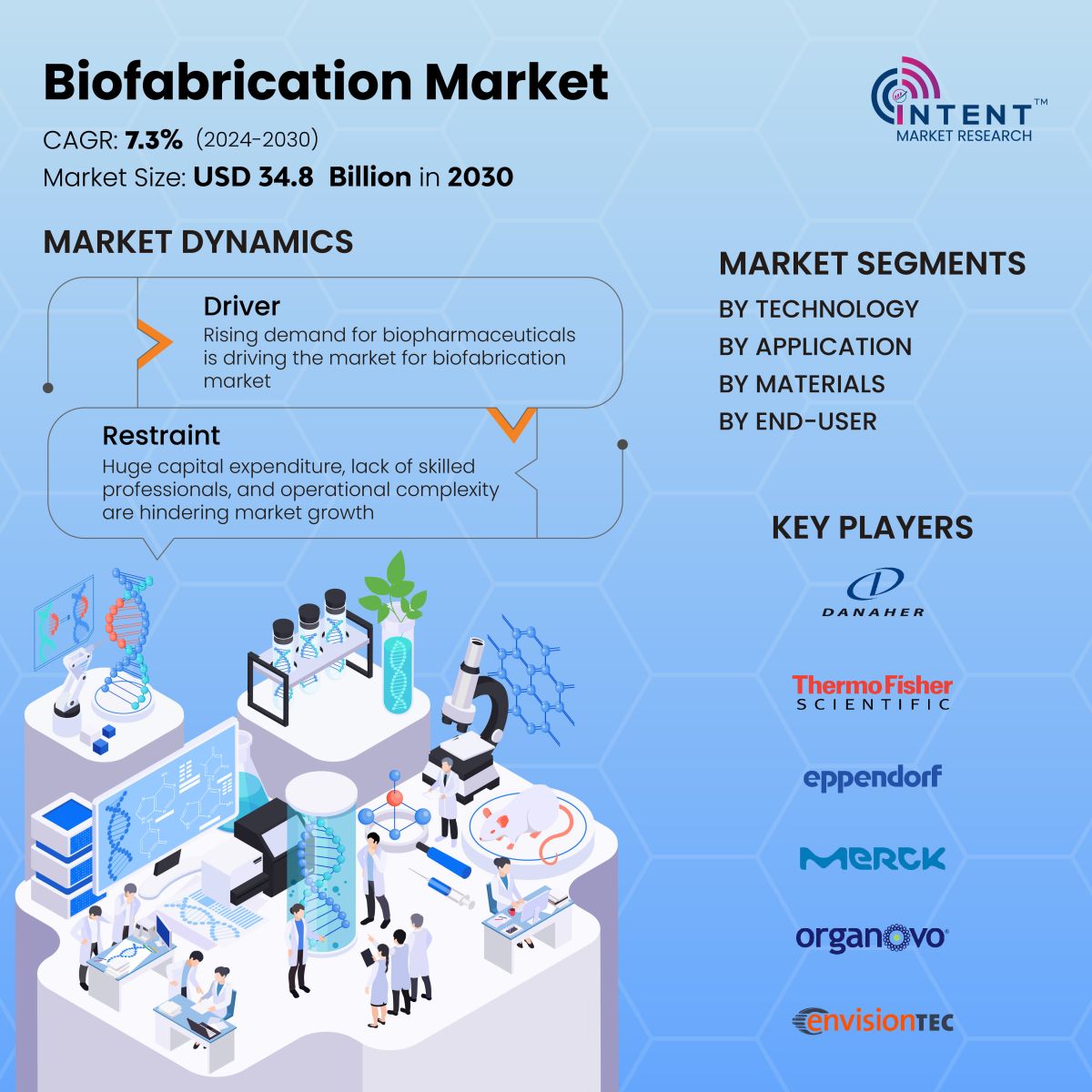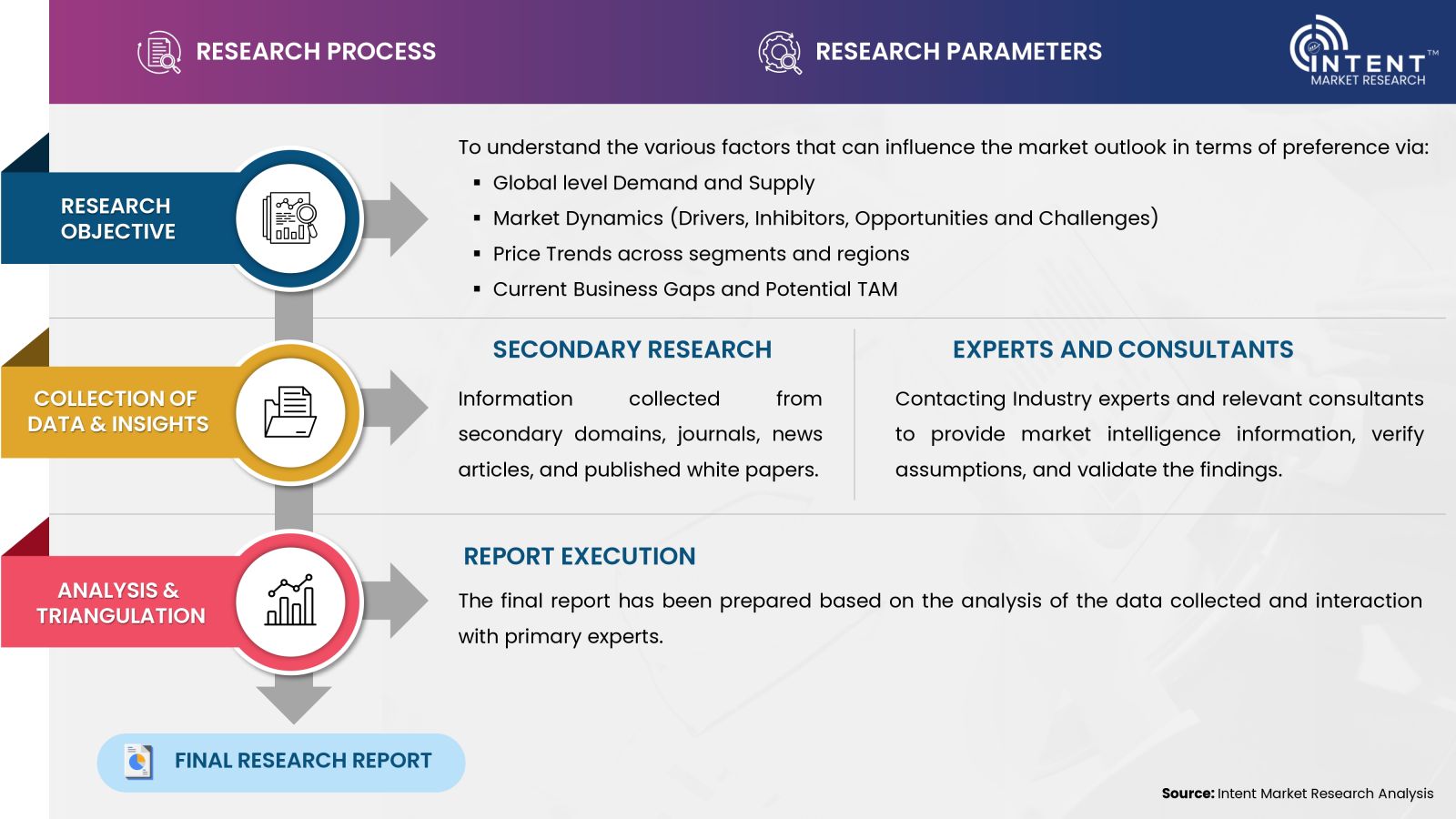According to Intent Market Research, the Biofabrication Market is expected to grow from USD 21.0 billion in 2023-e at a CAGR of 7.3% to touch USD 34.8 billion by 2030. Prominent players include Allevi, Cellink Global, Cyfuse Biomedical, Danaher, Envisiontec, Eppendorf, Inventia Life Science, Merck, Organovo Holdings, Poietis, Regemat 3D, Sartorius Stedim Biotech, Thermo Fisher Scientific, Vivax Bio and 3D Bioprinting Solutions. Decellularization of natural tissues and recellularization with patient-specific cells offer a unique avenue for biofabrication, which drives the growth of the market. Decellularization of natural tissues and recellularization with patient-specific cells offer a unique avenue for biofabrication, which drives the growth of the market.
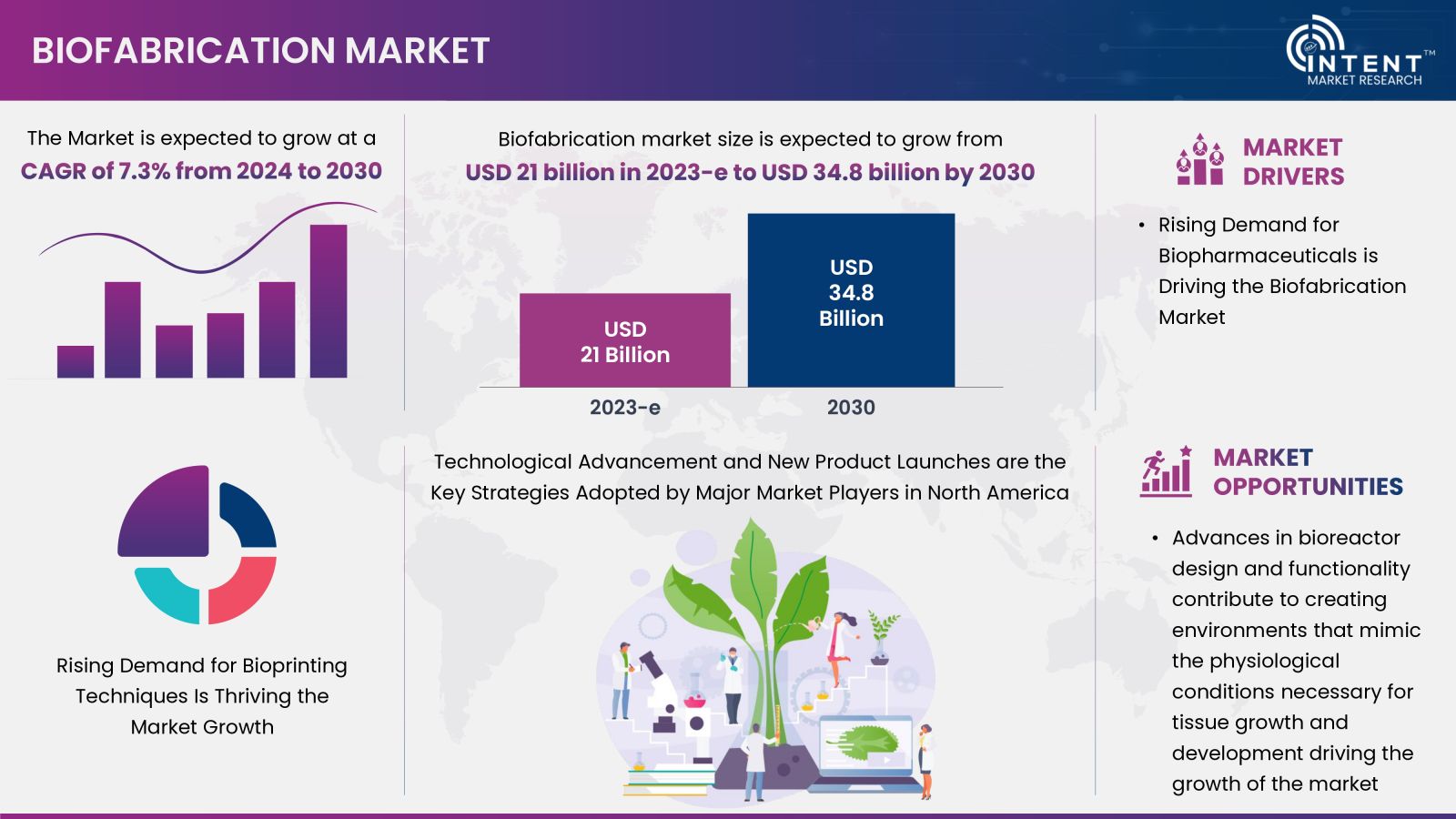
Biofabrication is an innovative field at the intersection of biology, engineering, and materials science. It involves the use of additive manufacturing (3D printing) and other advanced techniques to create biological structures, tissues, and even entire organs using a combination of living cells, biocompatible materials, and biomolecules. Biofabrication technique is used in variety of applications including regenerative medicine, tissue engineering, drug testing, and disease modeling.
Biofabrication Market Dynamics
Rising Demand for Biopharmaceuticals is Driving the Biofabrication Market
Biofabrication is a crucial process for drug testing and clinical trials and is expected to reduce the need for animal testing, making it both ethical and cost-effective. In the past, clinical trials for new drug development required testing on animals with artificially-induced affected tissues. Biofabrication techniques enable drug developers to swiftly identify potential complications linked to human clinical trials of new drugs, significantly minimizing losses incurred during late-stage failures.
Biofabricated organs help identify the side effects of drugs, helping developers streamline safe drug dosages for humans. This technology allows for quick drug discovery, and as of early 2022, there are 11,351 drugs in the pre-clinical phase of R&D, according to Pharma Intelligence. The US Food and Drug Administration regulatory agency is considering alternatives for drug safety and efficacy assessment, providing further scope for the market. Companies such as Organovo, which is based in the US, have played a vital role in developing a 3D bioprinter to create liver and kidney tissue for drug discovery applications.
Biofabrication Market Segment Insights
Rising Demand for Bioprinting Techniques Is Thriving the Market Growth
The growth of medical tourism in European countries is being driven by the ability of 3D Bioprinting to reduce drug reactions and expand treatment options. To improve healthcare infrastructure, the UK government invested USD 70 million in the industry strategy challenge fund. Three treatment centers for advanced therapy have also been established for advanced precision and gene therapy. The healthcare industry is being revolutionized by artificial intelligence, which is making it easier for healthcare professionals to monitor and track clinical data, thereby reducing errors.
In August 2020, AstraZeneca and Renalytix introduced strategies for the use of 3D bioprinting in the treatment of metabolic, renal, or cardiovascular diseases. Researchers at Seoul National University Hospital & College of Medicine have also developed an algorithm called Deep Learning Automatic Detection that analyzes chest radiographs to identify abnormal cancer growth. The market for 3D bioprinting experiences growth propelled by AI advancements.
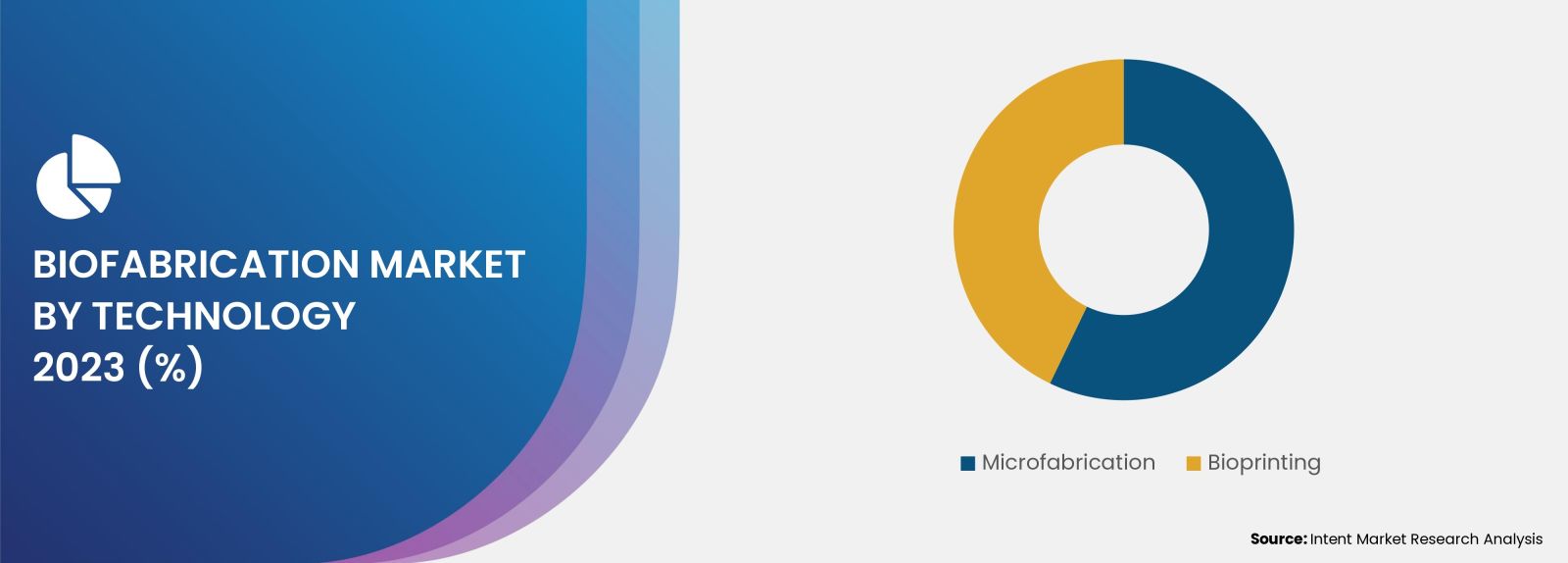
Increasing Demand for Biofabrication Techniques in Tissue Engineering is Responsible for Market Growth
Biofabrication constructs complex 3D tissues and organs using biocompatible materials and living cells. These advanced techniques in tissue engineering allow for the tailoring of tissues and organs to individual patients, improving compatibility and effectiveness while reducing the risk of immune rejection.
Advancements in 3D printing and biomaterials improve the precision and feasibility of biofabricated constructs, serving as valuable models for studying diseases, drug testing, and regenerative therapies. Biofabrication holds promise in clinical applications such as wound healing, reconstructive surgery, and implants for various medical conditions. Ongoing advancements will result in the development of increasingly sophisticated bioengineered tissues and organs for clinical applications.
The market for regenerative medicine and tissue engineering is growing due to the increasing number of clinical studies being conducted in this field. As per the clinicaltrials.gov website, there are approximately 58 studies related to regenerative medicine and 63 studies focusing on tissue engineering currently underway.
Synthetic Materials Create Scaffolds that Support Cellular Growth, and Tissue Formation Driving Market Growth
Synthetic materials are essential in tissue engineering. They can be engineered to exhibit specific properties, allowing researchers to tailor the characteristics of biomaterials to meet specific requirements. Many synthetic materials such as Polymers, Polyurethane (PU) & Polycaprolactone (PCL) are biocompatible, possess superior mechanical properties, and can degrade at controlled rates. They offer a wide range of options, making them suitable for widespread use in tissue engineering and biofabrication.
Synthetic materials are used in biofabrication to create structures that support the growth of living cells and tissues. These include polymers such as PLA, PGA, PCL, and PEG, synthetic hydrogels such as PEGDA and PNIPAAm, and synthetic ceramic materials such as hydroxyapatite and tricalcium phosphate. These materials are combined with living cells and bioactive molecules to create scaffolds that support tissue growth and development.
Biotechnology and Pharmaceutical Companies are the Major Revenue Contributors
Biotech and pharma firms heavily invest in R&D for advanced techniques, allowing the creation of human physiology-mimicking tissue models in biofabrication. This approach reduces both costs and time in drug testing. They explore producing tissues/organs for transplantation, addressing organ shortages, and developing regenerative therapies.
Companies take promising research from labs to market, collaborating with others to leverage resources. They fund biofabrication startups, pursue patents, and translate research into products, driving tech advancements and market growth. For instance, in June 2022, REGEMAT 3D and Humabiologics partnered to serve a wider customer base in the European Bioprinting and drug testing market.
Regional Insights
Technological Advancement and New Product Launches are the Key Strategies Adopted by Major Market Players in North America
North America dominates the biofabrication market owing to advanced technology that enables the diagnosis and treatment of chronic disorders. In addition to that the availability of private and government funding, and high healthcare spending is expected to fuel the market growth. Advancements in 3D tissue engineering technology and technological advancement would boost new product development in the biofabrication market.
For example, in April 2022, Organogenesis, a leading company in regenerative medicine, presented the latest advancements in their wound care research at the 2022 Symposium on Advanced Wound Care Conference held in Phoenix, Arizona. Their focus was on products such as PuraPly, Affinity, Apligraf, and Organogenesis Physician Solutions.
Competitive Landscape
The Mergers & Acquisitions by Major Players are driving the Biofabrication Market Growth
Biofabrication market is fiercely competitive, with numerous manufacturers vying for a significant share. Market participants employ essential strategies such as product launches, approvals, acquisitions, and innovations to sustain and expand their global presence. For instance, In January 2023, BioMed X and AbbVie extended their research partnership with a focus on immunology and tissue engineering. Prominent players include Allevi, Cellink Global, Cyfuse Biomedical, Danaher, Envisiontec, Eppendorf, Inventia Life Science, Merck, Organovo Holdings, Poietis, Regemat 3D, Sartorius Stedim Biotech, Thermo Fisher Scientific, Vivax Bio and 3D Bioprinting Solutions.
Biofabrication Market Coverage
The report provides key insights into the biofabrication market, and it focuses on technological developments, trends, and initiatives taken by the government. In this sector, analysis explores market drivers, restraints, opportunities, and other relevant factors. The report analyzes the market for biofabrication, including key players and competitive landscape.

Report Scope
|
Report Features |
Description |
|
Market Size (2023-e) |
USD 21.0 billion |
|
Forecast Revenue (2030) |
USD 34.8 billion |
|
CAGR (2024-2030) |
7.3% |
|
Base Year for Estimation |
2023-e |
|
Historic Year |
2022 |
|
Forecast Period |
2024-2030 |
|
Report Coverage |
Revenue Forecast, Market Dynamics, Competitive Landscape, Recent Developments |
|
Segments Covered |
By Technology (Bioprinting and Microfabrication), By Application (Tissue Engineering, Organ Transplantation, Disease Modeling, Drug Development, and Others), By Materials (Natural Materials and Synthetic Materials), By End-User (Academic and Research Institutions, Biotechnology and Pharmaceutical Companies, Hospitals, and Clinics and Others ) |
|
Regional Analysis |
North America (US, Canada), Europe (Germany, France, UK, Italy), Asia-Pacific (China, Japan, South Korea, India), Latin America (Brazil, Argentina), Middle East & Africa (Saudi Arabia, South Africa, United Arab Emirates) |
|
Competitive Landscape |
Allevi, Cellink Global, Cyfuse Biomedical, Danaher, Envisiontec, Eppendorf, Inventia Life Science, Merck, Organovo Holdings, Poietis, Regemat 3D, Sartorius Stedim Biotech, Thermo Fisher Scientific, Vivax Bio and 3D Bioprinting Solutions. |
|
Customization Scope |
Customization for segments, region/country-level will be provided. Moreover, additional customization can be done based on the requirements. |
|
Purchase Options |
We have three licenses to opt for Single User License, Multi-User License (Up to 5 Users), Corporate Use License (Unlimited User and Printable PDF) |
|
1. Introduction |
|
1. 1. Study Assumptions and Biofabrication Market Definition |
|
1.2. Scope of the Study |
|
2. Research Methodology |
|
3. Executive Summary |
|
4. Biofabrication Market Dynamics |
|
4.1. Market Growth Drivers |
|
4.2 Market Growth Challenges |
|
5. Biofabrication Market Outlook |
|
5.1. Investment & Funding Analysis |
|
5.2 Future Perspectives for Biofabrication |
|
5.3. Production Outlook |
|
5.4 Regulatory Scenario Analysis |
|
5.5. Emerging players in the industry |
|
5.6 Pestle Analysis |
|
5.7 Porters Five Forces |
|
5.8 Competitive Matrix |
|
5.9 Patent Analysis |
|
5.10 Value Chain Analysis |
|
6. Global Biofabrication Market Segmentation (Market Size & Forecast: USD billion, 2024 – 2030) |
|
6.1 Technology |
|
6.1.1 Bioprinting |
|
6.1.2 Microfabrication |
|
6.2 Application |
|
6.2.1 Tissue Engineering |
|
6.2.2 Organ Transplantation |
|
6.2.3 Disease Modeling |
|
6.2.4 Drug Development |
|
6.2.5 Others |
|
6.3 Materials |
|
6.3.1 Natural Materials |
|
6.3.2 Synthetic Materials |
|
6.4 End-User |
|
6.4.1 Academic and Research Institution |
|
6.4.2 Biotechnology and Pharmaceutical Companies |
|
6.4.3 Hospitals and Clinics |
|
6.4.4 Others |
|
6.5 Geography |
|
6.5.1 North America |
|
6.5.2 Europe |
|
6.5.3 Asia-Pacific |
|
6.5.4 Latin America |
|
6.5.5 Middle East and Africa |
|
7. North America Biofabrication Market Segmentation (Market Size & Forecast: USD billion, 2024 – 2030) |
|
7.1 Technology |
|
7.1.1 Bioprinting |
|
7.1.2 Microfabrication |
|
7.2 Application |
|
7.2.1 Tissue Engineering |
|
7.2.2 Organ Transplantation |
|
7.2.3 Disease Modeling |
|
7.2.4 Drug Development |
|
7.2.5 Others |
|
7.3 Materials |
|
7.3.1 Natural Materials |
|
7.3.2 Synthetic Materials |
|
7.4 End-User |
|
7.4.1 Academic and Research Institution |
|
7.4.2 Biotechnology and Pharmaceutical Companies |
|
7.4.3 Hospitals and Clinics |
|
7.4.4 Others |
|
7.5 Country |
|
7.5.1 United States |
|
7.5.1.1 Technology |
|
7.5.1.1.1 Bioprinting |
|
7.5.1.1.2 Microfabrication |
|
7.5.1.2 Application |
|
7.5.1.2.1 Tissue Engineering |
|
7.5.1.2.2 Organ Transplantation |
|
7.5.1.2.3 Disease Modeling |
|
7.5.1.2.4 Drug Development |
|
7.5.1.2.5 Others |
|
7.5.1.3 Materials |
|
7.5.1.3.1 Natural Materials |
|
7.5.1.3.2 Synthetic Materials |
|
7.5.1.4 End-User |
|
7.5.1.4.1 Academic and Research Institutions |
|
7.5.1.4.2 Biotechnology and Pharmaceutical Companies |
|
7.5.1.4.3 Hospitals and Clinics |
|
7.5.1.4.4 Others |
|
7.5.2 Canada |
|
7.5.2.1 Technology |
|
7.5.2.1.1 Bioprinting |
|
7.5.2.1.2 Microfabrication |
|
7.5.2.2 Application |
|
7.5.2.2.1 Tissue Engineering |
|
7.5.2.2.2 Organ Transplantation |
|
7.5.2.2.3 Disease Modeling |
|
7.5.2.2.4 Drug Development |
|
7.5.2.2.5 Others |
|
7.5.2.3 Materials |
|
7.5.2.3.1 Natural Materials |
|
7.5.2.3.2 Synthetic Materials |
|
7.5.2.4 End-User |
|
7.5.2.4.1 Academic and Research Institutions |
|
7.5.2.4.2 Biotechnology and Pharmaceutical Companies |
|
7.5.2.4.3 Hospitals and Clinics |
|
7.5.2.4.4 Others |
|
8. Europe Market Biofabrication Segmentation (Market Size & Forecast: USD billion, 2024 – 2030) |
|
8.1 Technology |
|
8.1.1 Bioprinting |
|
8.1.2 Microfabrication |
|
8.2 Application |
|
8.2.1 Tissue Engineering |
|
8.2.2 Organ Transplantation |
|
8.2.3 Disease Modeling |
|
8.2.4 Drug Development |
|
8.2.5 Others |
|
8.3 Materials |
|
8.3.1 Natural Materials |
|
8.3.2 Synthetic Materials |
|
8.4 End-User |
|
8.4.1 Academic and Research Institution |
|
8.4.2 Biotechnology and Pharmaceutical Companies |
|
8.4.3 Hospitals and Clinics |
|
8.4.4 Others |
|
8.5 Country |
|
8.5.1 United Kingdom |
|
8.5.1.1 Technology |
|
8.5.1.1.1 Bioprinting |
|
8.5.1.1.2 Microfabrication |
|
8.5.1.2 Application |
|
8.5.1.2.1 Tissue Engineering |
|
8.5.1.2.2 Organ Transplantation |
|
8.5.1.2.3 Disease Modeling |
|
8.5.1.2.4 Drug Development |
|
8.5.1.2.5 Others |
|
8.5.1.3 Materials |
|
8.5.1.3.1 Natural Materials |
|
8.5.1.3.2 Synthetic Materials |
|
8.5.1.4 End-User |
|
8.5.1.4.1 Academic and Research Institutions |
|
8.5.1.4.2 Biotechnology and Pharmaceutical Companies |
|
8.5.1.4.3 Hospitals and Clinics |
|
8.5.1.4.4 Others |
|
8.5.2 France |
|
8.5.2.1 Technology |
|
8.5.2.1.1 Bioprinting |
|
8.5.2.1.2 Microfabrication |
|
8.5.2.2 Application |
|
8.5.2.2.1 Tissue Engineering |
|
8.5.2.2.2 Organ Transplantation |
|
8.5.2.2.3 Disease Modeling |
|
8.5.2.2.4 Drug Development |
|
8.5.2.2.5 Others |
|
8.5.2.3 Materials |
|
8.5.2.3.1 Natural Materials |
|
8.5.2.3.2 Synthetic Materials |
|
8.5.2.4 End-User |
|
8.5.2.4.1 Academic and Research Institutions |
|
8.5.2.4.2 Biotechnology and Pharmaceutical Companies |
|
8.5.2.4.3 Hospitals and Clinics |
|
8.5.2.4.4 Others |
|
8.5.3 Germany |
|
8.5.3.1 Technology |
|
8.5.3.1.1 Bioprinting |
|
8.5.3.1.2 Microfabrication |
|
8.5.3.2 Application |
|
8.5.3.2.1 Tissue Engineering |
|
8.5.3.2.2 Organ Transplantation |
|
8.5.3.2.3 Disease Modeling |
|
8.5.3.2.4 Drug Development |
|
8.5.3.2.5 Others |
|
8.5.3.3 Materials |
|
8.5.3.3.1 Natural Materials |
|
8.5.3.3.2 Synthetic Materials |
|
8.5.3.4 End-User |
|
8.5.3.4.1 Academic and Research Institutions |
|
8.5.3.4.2 Biotechnology and Pharmaceutical Companies |
|
8.5.3.4.3 Hospitals and Clinics |
|
8.5.3.4.4 Others |
|
8.5.4 Italy |
|
8.5.4.1 Technology |
|
8.5.4.1.1 Bioprinting |
|
8.5.4.1.2 Microfabrication |
|
8.5.4.2 Application |
|
8.5.4.2.1 Tissue Engineering |
|
8.5.4.2.2 Organ Transplantation |
|
8.5.4.2.3 Disease Modeling |
|
8.5.4.2.4 Drug Development |
|
8.5.4.2.5 Others |
|
8.5.4.3 Materials |
|
8.5.4.3.1 Natural Materials |
|
8.5.4.3.2 Synthetic Materials |
|
8.5.4.4 End-User |
|
8.5.4.4.1 Academic and Research Institutions |
|
8.5.4.4.2 Biotechnology and Pharmaceutical Companies |
|
8.5.4.4.3 Hospitals and Clinics |
|
8.5.4.4.4 Others |
|
9. Asia Pacific Biofabrication Market Segmentation (Market Size & Forecast: USD billion, 2024 – 2030) |
|
9.1 Technology |
|
9.1.1 Bioprinting |
|
9.1.2 Microfabrication |
|
9.2 Application |
|
9.2.1 Tissue Engineering |
|
9.2.2 Organ Transplantation |
|
9.2.3 Disease Modeling |
|
9.2.4 Drug Development |
|
9.2.5 Others |
|
9.3 Materials |
|
9.3.1 Natural Materials |
|
9.3.2 Synthetic Materials |
|
9.4 End-User |
|
9.4.1 Academic and Research Institution |
|
9.4.2 Biotechnology and Pharmaceutical Companies |
|
9.4.3 Hospitals and Clinics |
|
9.4.4 Others |
|
9.5 Country |
|
9.5.1 China |
|
9.5.1.1 Technology |
|
9.5.1.1.1 Bioprinting |
|
9.5.1.1.2 Microfabrication |
|
9.5.1.2 Application |
|
9.5.1.2.1 Tissue Engineering |
|
9.5.1.2.2 Organ Transplantation |
|
9.5.1.2.3 Disease Modeling |
|
9.5.1.2.4 Drug Development |
|
9.5.1.2.5 Others |
|
9.5.1.3 Materials |
|
9.5.1.3.1 Natural Materials |
|
9.5.1.3.2 Synthetic Materials |
|
9.5.1.4 End-User |
|
9.5.1.4.1 Academic and Research Institutions |
|
9.5.1.4.2 Biotechnology and Pharmaceutical Companies |
|
9.5.1.4.3 Hospitals and Clinics |
|
9.5.1.4.4 Others |
|
9.5.2 Japan |
|
9.5.2.1 Technology |
|
9.5.2.1.1 Bioprinting |
|
9.5.2.1.2 Microfabrication |
|
9.5.2.2 Application |
|
9.5.2.2.1 Tissue Engineering |
|
9.5.2.2.2 Organ Transplantation |
|
9.5.2.2.3 Disease Modeling |
|
9.5.2.2.4 Drug Development |
|
9.5.2.2.5 Others |
|
9.5.2.3 Materials |
|
9.5.2.3.1 Natural Materials |
|
9.5.2.3.2 Synthetic Materials |
|
9.5.2.4 End-User |
|
9.5.2.4.1 Academic and Research Institutions |
|
9.5.2.4.2 Biotechnology and Pharmaceutical Companies |
|
9.5.2.4.3 Hospitals and Clinics |
|
9.5.2.4.4 Others |
|
9.5.3 South Korea |
|
9.5.3.1 Technology |
|
9.5.3.1.1 Bioprinting |
|
9.5.3.1.2 Microfabrication |
|
9.5.3.2 Application |
|
9.5.3.2.1 Tissue Engineering |
|
9.5.3.2.2 Organ Transplantation |
|
9.5.3.2.3 Disease Modeling |
|
9.5.3.2.4 Drug Development |
|
9.5.3.2.5 Others |
|
9.5.3.3 Materials |
|
9.5.3.3.1 Natural Materials |
|
9.5.3.3.2 Synthetic Materials |
|
9.5.3.4 End-User |
|
9.5.3.4.1 Academic and Research Institutions |
|
9.5.3.4.2 Biotechnology and Pharmaceutical Companies |
|
9.5.3.4.3 Hospitals and Clinics |
|
9.5.3.4.4 Others |
|
9.5.4 India |
|
9.5.4.1 Technology |
|
9.5.4.1.1 Bioprinting |
|
9.5.4.1.2 Microfabrication |
|
9.5.4.2 Application |
|
9.5.4.2.1 Tissue Engineering |
|
9.5.4.2.2 Organ Transplantation |
|
9.5.4.2.3 Disease Modeling |
|
9.5.4.2.4 Drug Development |
|
9.5.4.2.5 Others |
|
9.5.4.3 Materials |
|
9.5.4.3.1 Natural Materials |
|
9.5.4.3.2 Synthetic Materials |
|
9.5.4.4 End-User |
|
9.5.4.4.1 Academic and Research Institutions |
|
9.5.4.4.2 Biotechnology and Pharmaceutical Companies |
|
9.5.4.4.3 Hospitals and Clinics |
|
9.5.4.4.4 Others |
|
10. Latin America Biofabrication Market Segmentation (Market Size & Forecast: USD billion, 2024 – 2030) |
|
10.1 Technology |
|
10.1.1 Bioprinting |
|
10.1.2 Microfabrication |
|
10.2 Application |
|
10.2.1 Tissue Engineering |
|
10.2.2 Organ Transplantation |
|
10.2.3 Disease Modeling |
|
10.2.4 Drug Development |
|
10.2.5 Others |
|
10.3 Materials |
|
10.3.1 Natural Materials |
|
10.3.2 Synthetic Materials |
|
10.4 End-User |
|
10.4.1 Academic and Research Institution |
|
10.4.2 Biotechnology and Pharmaceutical Companies |
|
10.4.3 Hospitals and Clinics |
|
10.4.4 Others |
|
10.5 Country |
|
10.5.1 Brazil |
|
10.5.1.1 Technology |
|
10.5.1.1.1 Bioprinting |
|
10.5.1.1.2 Microfabrication |
|
10.5.1.2 Application |
|
10.5.1.2.1 Tissue Engineering |
|
10.5.1.2.2 Organ Transplantation |
|
10.5.1.2.3 Disease Modeling |
|
10.5.1.2.4 Drug Development |
|
10.5.1.2.5 Others |
|
10.5.1.3 Materials |
|
10.5.1.3.1 Natural Materials |
|
10.5.1.3.2 Synthetic Materials |
|
10.5.1.4 End-User |
|
10.5.1.4.1 Academic and Research Institutions |
|
10.5.1.4.2 Biotechnology and Pharmaceutical Companies |
|
10.5.1.4.3 Hospitals and Clinics |
|
10.5.1.4.4 Others |
|
10.5.3 Argentina |
|
10.5.3.1 Technology |
|
10.5.3.1.1 Bioprinting |
|
10.5.3.1.2 Microfabrication |
|
10.5.3.2 Application |
|
10.5.3.2.1 Tissue Engineering |
|
10.5.3.2.2 Organ Transplantation |
|
10.5.3.2.3 Disease Modeling |
|
10.5.3.2.4 Drug Development |
|
10.5.3.2.5 Others |
|
10.5.3.3 Materials |
|
10.5.3.3.1 Natural Materials |
|
10.5.3.3.2 Synthetic Materials |
|
10.5.3.4 End-User |
|
10.5.3.4.1 Academic and Research Institutions |
|
10.5.3.4.2 Biotechnology and Pharmaceutical Companies |
|
10.5.3.4.3 Hospitals and Clinics |
|
10.5.3.4.4 Others |
|
11. Middle East & Africa Biofabrication Market Segmentation (Market Size & Forecast: USD billion, 2024 – 2030) |
|
11.1 Technology |
|
11.1.1 Bioprinting |
|
11.1.2 Microfabrication |
|
11.2 Application |
|
11.2.1 Tissue Engineering |
|
11.2.2 Organ Transplantation |
|
11.2.3 Disease Modeling |
|
11.2.4 Drug Development |
|
11.2.5 Others |
|
11.3 Materials |
|
11.3.1 Natural Materials |
|
11.3.2 Synthetic Materials |
|
11.4 End-User |
|
11.4.1 Academic and Research Institution |
|
11.4.2 Biotechnology and Pharmaceutical Companies |
|
11.4.3 Hospitals and Clinics |
|
11.4.4 Others |
|
11.5 Country |
|
11.5.1 Saudi Arabia |
|
11.5.1.1 Technology |
|
11.5.1.1.1 Bioprinting |
|
11.5.1.1.2 Microfabrication |
|
11.5.1.2 Application |
|
11.5.1.2.1 Tissue Engineering |
|
11.5.1.2.2 Organ Transplantation |
|
11.5.1.2.3 Disease Modeling |
|
11.5.1.2.4 Drug Development |
|
11.5.1.2.5 Others |
|
11.5.1.3 Materials |
|
11.5.1.3.1 Natural Materials |
|
11.5.1.3.2 Synthetic Materials |
|
11.5.1.4 End-User |
|
11.5.1.4.1 Academic and Research Institutions |
|
11.5.1.4.2 Biotechnology and Pharmaceutical Companies |
|
11.5.1.4.3 Hospitals and Clinics |
|
11.5.1.4.4 Others |
|
11.5.2 South Africa |
|
11.5.2.1 Technology |
|
11.5.2.1.1 Bioprinting |
|
11.5.2.1.2 Microfabrication |
|
11.5.2.2 Application |
|
11.5.2.2.1 Tissue Engineering |
|
11.5.2.2.2 Organ Transplantation |
|
11.5.2.2.3 Disease Modeling |
|
11.5.2.2.4 Drug Development |
|
11.5.2.2.5 Others |
|
11.5.2.3 Materials |
|
11.5.2.3.1 Natural Materials |
|
11.5.2.3.2 Synthetic Materials |
|
11.5.2.4 End-User |
|
11.5.2.4.1 Academic and Research Institutions |
|
11.5.2.4.2 Biotechnology and Pharmaceutical Companies |
|
11.5.2.4.3 Hospitals and Clinics |
|
11.5.2.4.4 Others |
|
11.5.3 United Arab Emirates |
|
11.5.3.1 Technology |
|
11.5.3.1.1 Bioprinting |
|
11.5.3.1.2 Microfabrication |
|
11.5.3.2 Application |
|
11.5.3.2.1 Tissue Engineering |
|
11.5.3.2.2 Organ Transplantation |
|
11.5.3.2.3 Disease Modeling |
|
11.5.3.2.4 Drug Development |
|
11.5.3.2.5 Others |
|
11.5.3.3 Materials |
|
11.5.3.3.1 Natural Materials |
|
11.5.3.3.2 Synthetic Materials |
|
11.5.3.4 End-User |
|
11.5.3.4.1 Academic and Research Institutions |
|
11.5.3.4.2 Biotechnology and Pharmaceutical Companies |
|
11.5.3.4.3 Hospitals and Clinics |
|
11.5.3.4.4 Others |
|
12. Competitive Landscape |
|
12.1 Company Market Share Analysis |
|
12.2 Competitive Matrix |
|
12.2 Product Benchmarking |
|
12.3 Company Profiles (Manufacturers of Biofabrication) |
|
12.3.1 Thermo Fisher Scientific |
|
12.3.1.1 Company Synopsis |
|
12.3.1.2 Company Financials |
|
12.3.1.3 Product/ Service Portfolio |
|
12.3.1.4 Recent Developments |
|
12.3.2 Danaher |
|
12.3.3 Merck KGaA |
|
12.3.4 Sartorius Stedim Biotech |
|
12.3.5 Eppendorf |
|
12.3.6 Envisiontec |
|
12.3.7 Organovo Holdings |
|
12.3.8 Inventia Life Science |
|
12.3.9 Poietis |
|
12.3.10 Vivax Bio |
|
12.3.11 Allevi |
|
12.3.12 Cyfuse Biomedical K.K |
|
12.4 Company Profiles (Demand Side) |
|
12.4.1 Bluebird Bio |
|
12.4.1.1 Company Synopsis |
|
12.3.1.2 Company Financials |
|
12.3.1.3 Product/ Service Portfolio |
|
12.3.1.4 Recent Developments |
|
12.4.2 CRISPR Therapeutics |
|
12.4.3 Intellia Therapeutics |
|
12.4.4 Editas Medicine |
|
12.4.5 ReNeuron |
|
13. Analyst Recommendations |
Intent Market Research employs a rigorous methodology to minimize residual errors by carefully defining the scope, validating findings through primary research, and consistently updating our in-house database. This dynamic approach allows us to capture ongoing market fluctuations and adapt to evolving market uncertainties.
The research factors used in our methodology vary depending on the market being analyzed. To begin with, we incorporate both demand and supply side information into our model to identify and address market gaps. Additionally, we also employ approaches such as Macro-Indicator Analysis, Factor Analysis, Value Chain-Based Sizing, and forecasting to further increase the accuracy of the numbers and validate the findings.
Research Approach
- Secondary Research Approach: During the initial phase of the research process, we acquire and accumulate extensive data continuously. This data is carefully filtered and validated through a variety of secondary sources.
- Primary Research Approach: Following the consolidation of data gathered through secondary research, we initiate a validation process to verify all the market numbers, and assumptions and validate the findings by engaging with subject matter experts.
Data Collection, Analysis and Interpretation:
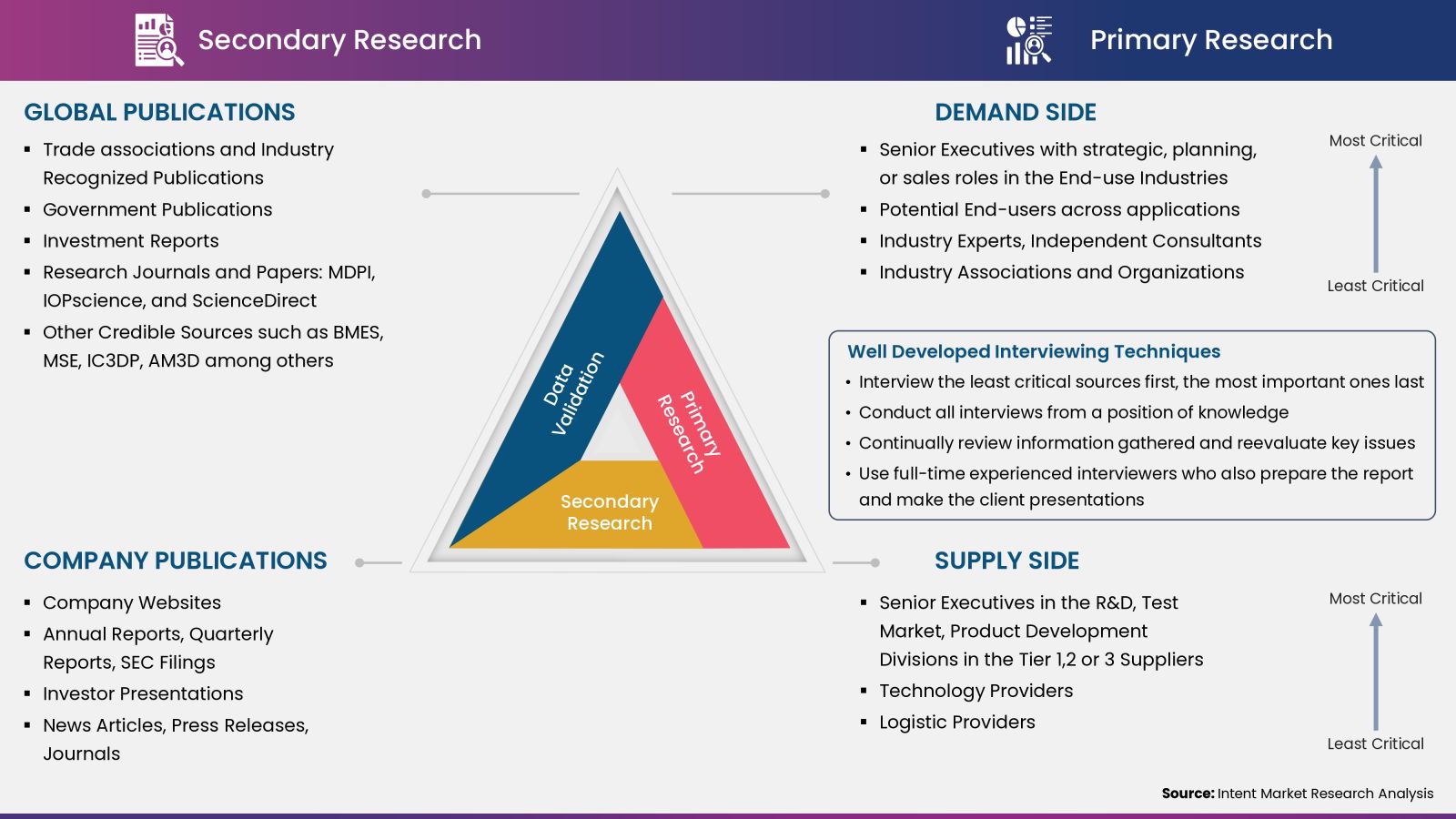
Research Methodology
Our market research methodology utilizes both top-down and bottom-up approaches to segment and estimate quantitative aspects of the market. We also employ multi-perspective analysis, examining the market from distinct viewpoints.
